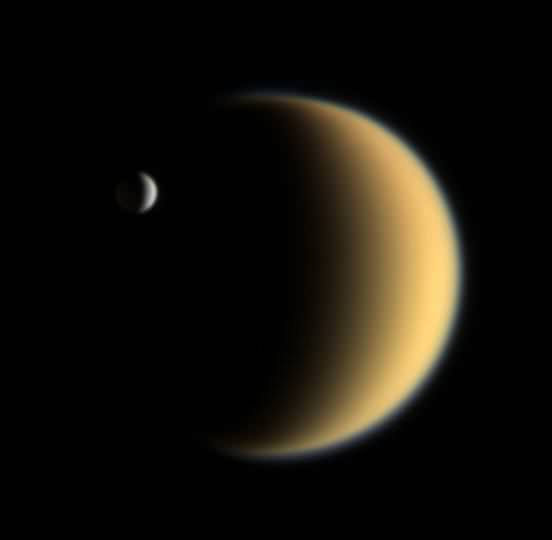[/caption]
Titan, the largest moon of Saturn, is in some ways the most Earth-like world in the solar system, with a thick nitrogen atmosphere, rain, rivers, lakes and seas. Albeit it is much colder, and liquid methane/ethane takes the place of water, but the hydrological processes are quite similar to those here. There may, however, also be a liquid water-ammonia ocean below the surface. Now, new research suggests that Titan is Earth-like in another way as well, with a layered lower atmosphere similar to ours.
It’s been long known that Titan has a dense atmosphere; you can’t even see the surface due to a thick smog-like upper haze composed of hydrocarbons. As it turns out, the lower atmosphere has two distinct layers; the lowest layer, like on Earth, is known as the boundary layer, which has the most influence on climate and weather.
There has been a lot of uncertainty about the nature of Titan’s lower atmosphere, so scientists developed a 3-D climate model to try to answer those questions – previous data from Voyager 1, Cassini and Huygens had led to conflicting results. This was largely due to the fact that the lower atmosphere can’t be observed directly because of the opaque upper atmosphere. The new climate model shows that there are two lower layers which are distinct from each other as well as from the upper atmosphere. The lowest boundary layer is about 800 metres (2,600 feet) thick while the next layer is about 2 kilometers (1.2 miles) deep.
According to Paulo Penteado from the Institute of Astronomy, Geophysics and Atmospheric Science at the University of São Paulo in Brazil, “The most interesting point is that their model shows the presence of two different boundaries, the lower one caused by the daily heating and cooling of the surface – and varying in height during the day – and the higher one caused by the seasonal change in global air circulation.”
Benjamin Charnay from the French National Centre for Scientific Research (CNRS) in Paris and lead author of the study, adds: “This unprecedented organisation of the boundary layer has several consequences. It controls the atmospheric circulation and wind patterns in the lower atmosphere; it controls the size and spacing of dunes on Titan; it could imply the formation of boundary layer clouds (of methane on Titan). Such clouds seem to have been observed but not explained.”
These differences are surprising, since Titan receives far less solar energy from the Sun than Earth does. This solar insulation, which determines temperature variations in the atmosphere, is 1,000 times weaker on Titan than on Earth. Such a dynamic atmosphere on Titan was unexpected, but it may hold clues as to the formation of our own atmosphere. This could also be extrapolated to exoplanets; if a smaller world so far from the Sun can have unanticipated Earth-like conditions, how many exoplanets, now being discovered by the thousands, could as well?
The findings were published in the January 15, 2012 issue of Nature Geoscience.
From the abstract:
“We conclude that Titan’s troposphere is well structured, featuring two boundary layers that control wind patterns, dune spacing and cloud formation at low altitudes.”
The abstract and article are here. The full article is available for $18.00 US or by subscription to Nature Geoscience.


Titan continues to be more and more interesting; it’s time to land a robotic rover on its surface! LC, how difficult would this be? I’m well aware of Huygens, but we need a craft that can provide more definitive data.